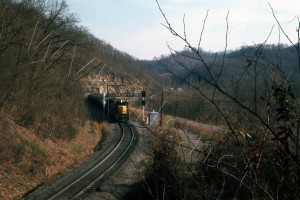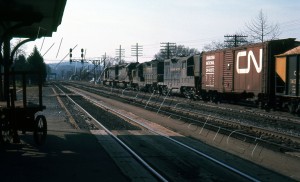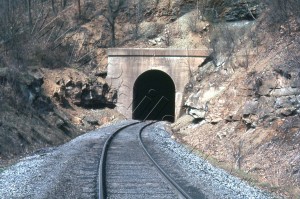Train #3 The Fast Flying Virginian at St Albans on a cool March day in 1967. In just a little over a year This scene will be but just a memory.
Another favorite place of mine to photograph trains was around the St. Albans area. St Albans is located along the Kanawha River approximately 12 miles west of downtown Charleston. It is situated at the point where Coal River flows into the Kanawha. It is one of the few rivers in the United States besides the Kanawha, New and Monongahela that flows north. If you are interested in reading up on the history of St Albans you can go to www.stablanshistory.com and click on the various links.
 Three EMD SD-18s leading a coal train westbound is about to pass the St Albans Depot in March 1967. The train is coming off the Coal River Branch.
Three EMD SD-18s leading a coal train westbound is about to pass the St Albans Depot in March 1967. The train is coming off the Coal River Branch.
In addition to main line of the Chesapeake and Ohio Railway passing through St. Albans, the Coal River Branch joined the C&O main approximately half a mile east of the St Albans depot. The junction afforded loaded coal trains coming from the coal fields the option to head east toward the coal loading piers at Newport News, Va or north toward the Great Lakes.
 Coal Train on the Coal River Branch is heading geographically north toward the C&O main which is about a half mile from this point. The telltales hanging from the support next to the signal warns crew of an approaching low clearance which in this case is St. Albans Tunnel.
Coal Train on the Coal River Branch is heading geographically north toward the C&O main which is about a half mile from this point. The telltales hanging from the support next to the signal warns crew of an approaching low clearance which in this case is St. Albans Tunnel.
The depot at St Albans was the location I enjoyed the most. The depot had a small umbrella shed the length of the building that paralleled the main track. It was a good place to be under during the hot summers to wait on the next train to come by. Besides movements on the mainline, you could catch an occasional coal train coming off the Coal River line heading westbound.
 Caboose of same train about to enter in St Albans Tunnel. The head end of the train should be already on the mainline.
Caboose of same train about to enter in St Albans Tunnel. The head end of the train should be already on the mainline.
The Coal River Branch of the C&O followed its namesake for most of the way south from St Albans. Approximately 15 miles south of town near the community of Alum Creek, the Coal split into the Big Coal and Little Coal rivers. The Coal River Branch followed the Big Coal for another couple of miles below that point to the community of Sproul, where the line splits. From this point there were branches running along Big and Little Coal rivers to coal mines further south.
The Coal River Branch started out as the Coal River and Western around 1901 and later became the Coal River Railroad. The C&O had been built through this area in the early 1870’s to a far as Huntington. As you can see on the map below, the branch took winding route through town. Approximately 20 years later the the junction of the now Coal River Branch was relocated approximately a three tenths of a mile east of the original junction. This was most likely done to keep trains from blocking city streets. The current alignment is all grade separated. A stub of the old junction off the C&O main in town which ran as far as 6th Ave remained for a number of years. It is has now been removed.
 Map of St Albans showing the C&O Main Line running across the upper half of the map from left to right. The Coal River Branch is on the right side of the map running north and south where St Albans tunnel is noted. The line in red is the original Coal River Branch that the C&O purchased from the Coal River Railroad around 1906.
Map of St Albans showing the C&O Main Line running across the upper half of the map from left to right. The Coal River Branch is on the right side of the map running north and south where St Albans tunnel is noted. The line in red is the original Coal River Branch that the C&O purchased from the Coal River Railroad around 1906.
 View looking north toward St Albans Tunnel. The track to the left was the original Coal River Branch that followed Pennsylvania Ave into town. Only a couple hundred feet remained back in the 1960’s. The track may have been left to store Maintenance of Way equipment or used to set off bad order cars. Today this track is gone.
View looking north toward St Albans Tunnel. The track to the left was the original Coal River Branch that followed Pennsylvania Ave into town. Only a couple hundred feet remained back in the 1960’s. The track may have been left to store Maintenance of Way equipment or used to set off bad order cars. Today this track is gone.
Much has changed since the formation of CSX in 1980 but in the last couple of years, beginning around 2009, the mainline of the former C&O has taken on a new look. Gone are the old C&O style signals. They have been replaced by newer type or as I have heard some say Seaboard style signals. Also the communication lines are practically gone now. The old depot is still there thanks to the efforts of those who have worked hard to keep the memories of the C&O alive for years to come. If you are in the area I strongly suggest stopping by for a visit.
 Westbound freight on the westward siding. In the distance you can see the wayside signal with a medium clear signal (red over green) which indicates the engineer has authority to go on the #1 main track. Way in the distance just to the right of the big evergreen trees is the bridge over Coal River.
Westbound freight on the westward siding. In the distance you can see the wayside signal with a medium clear signal (red over green) which indicates the engineer has authority to go on the #1 main track. Way in the distance just to the right of the big evergreen trees is the bridge over Coal River.
 View of St Albans Cabin. The operator controlled train movements on the Coal River line. The building was located near the west leg of the wye.
View of St Albans Cabin. The operator controlled train movements on the Coal River line. The building was located near the west leg of the wye.
 Another view of the south portal of St Albans Tunnel. The north end was inaccessible because it was in a deep narrow cut that would put a person in danger if a train came. Even though the tunnel was a few hundred feet long the curvature prevented a person from seeing the other end. Besides you would be trespassing on railroad property.
Another view of the south portal of St Albans Tunnel. The north end was inaccessible because it was in a deep narrow cut that would put a person in danger if a train came. Even though the tunnel was a few hundred feet long the curvature prevented a person from seeing the other end. Besides you would be trespassing on railroad property.
 Westbound coal drag passing by the St Albans Depot with three SD-18s on the head end. The units were originally delivered to the C&O in the 1800 series. They were renumbered a few years later to the 7300 series in anticipation of a merger with the Norfolk and Western Railway which did not occur because of the bankruptcy of Penn Central and other northeast railroads.
Westbound coal drag passing by the St Albans Depot with three SD-18s on the head end. The units were originally delivered to the C&O in the 1800 series. They were renumbered a few years later to the 7300 series in anticipation of a merger with the Norfolk and Western Railway which did not occur because of the bankruptcy of Penn Central and other northeast railroads.
 View of a part of the St Albans Yard east of the depot looking east. Westbound freight is on the Westward Siding. This is the same train shown passing the depot a few pictures above. In the background is the junction of the Coal River Branch just beyond the sand tower.
View of a part of the St Albans Yard east of the depot looking east. Westbound freight is on the Westward Siding. This is the same train shown passing the depot a few pictures above. In the background is the junction of the Coal River Branch just beyond the sand tower.


I am interested in understanding how the original branch of the Coal & Western off of the C&O line was set up to handle the elevation change in St. Albans. Was it done with a wooden tressel to get the train up from 7th Avenue to Pennsylvania Avenue?
Charlie,
I don’t know but you could contact the C&O Historical Society in Clifton Forge to see if they might have something on this. In the meantime I might ask anyone on the C&O yahoo group if they know.
The photos of St.Albans are most interesting to me. My grandparents lived at 504 4th Ave. from about 1949 to 1955. The house, still there, is just out of view to the right in the picture of the approaching SD-18s looking east. I walked the depot platform many times during those years and saw lots of steam action which helped forge my interest in the C&O which continues to this day. I had not previously seen such detailed photos of this location. They may be unique. Thanks Doug.
Love these photos. My house is shown in the third photo on the page, on the left. We lived at 610 Third Ave, facing the tracks, from 1962-70. The house is now gone. The houses shown and the view of Shoney’s drive in all bring back memories, and I can still feel the rocking of the bed as the coal trains passed through at night. We slept right through them, though! Thanks for posting these.
I’m glad you enjoyed the photos. This was one of my favorite places to photograph C&O trains. You might have seen me out there with my camera.
Doug, I just found some photos of a steam train going through St. Albans in October 1981, taken by my dad. Also, I found photos of the Centennial Train parked in St. Albans in 1963, taken from Third Avenue, near Shoney’s. If you want these, send me an email address, and I will be glad to share. I posted them to the Memories of St. Albans Facebook page, as well, in a photo album called St. Albans Trains. You can find me on Facebook, too, as Susan E Kelley.
This is a great website… I grew up in Sun Valley (the first neighborhood on the other side of the SA Tunnel) and watched many a train go by on those tracks… thank you for taking the time to put this together and share the photos…
Hi-I grew up in St.Albans back in the 1960’s/70’s. The C&O Rail Road tracks and tunnel provided countless hours of exploration and adventure to a generation (or two) of kids! True we were always in trespass on C&O property plus the obvious dangers but we played it safe and stayed out of trouble with the “cinder dicks”…I remember when a group of us did our first walk into the tunnel-talk about being scared, putting our ears down on the rail and listening for any oncoming train. Also we would hop slow moving coal trains and ride through the tunnel on our way to swim at Coal River. Forever memories of Summer and what now can be called a bygone era! Those where the days. God Bless Chessie System…..
St Albans was a great place to photograph trains. I’m thankful for the memories.
My dad used to tell me that other than the construction crew, he and his brother (young boys) were the first non-railroad folks to go through the St. Albans tunnel one evening after the construction crew left.
As a kid in the 1960’s, I walked through the tunnel several times not realizing I was trespassing… Once I did it by myself. Every so often in the tunnel is a niche in the tunnel wall you could step into if you got caught in there by a train, though if I remember correctly your feet would have gotten wet in dirty old water.
You are correct… because the tunnel is curved, when you enter it you can’t see “the light at the end of the tunnel”. I was always glad when I got far enough in to see that light at the other end, because it was really spooky.
2nd time
Hi,
Why is there no articles or pictures of the train wreck that happened in the 1960’s, in front of the Train Depot, in St. Albans, WV.
There were many Coal Cars turned over, many of them near houses there.
It be be nice to read about that. I was probably 10 years old or so. But remember my Dad and I walking around looking at it. It was terrible.
The intent of the piece was to highlight St. Albans in the days of the former C&O. Yes, I remember the derailment. My family and I drove over from Nitro, where we lived at the time, to view the wreckage. I have an article from the Charleston newspaper somewhere that showed a picture of the wreck. If I can locate it, I will send you a scanned copy.
Doug Bess,
I would like to use Your Yello Caboose entering the Tunnel in St Albans in an Article I am writing (Tribute to a Model Railroader) can you send me an e-mail to GNTrainman@outlook.com? Confirming permission? I will need that as it is the only picture in my article that is not mine. Thanks.
Andy J. Zimmerman
ATCS AW USN Ret
NMRA Standards and Conformance Manager